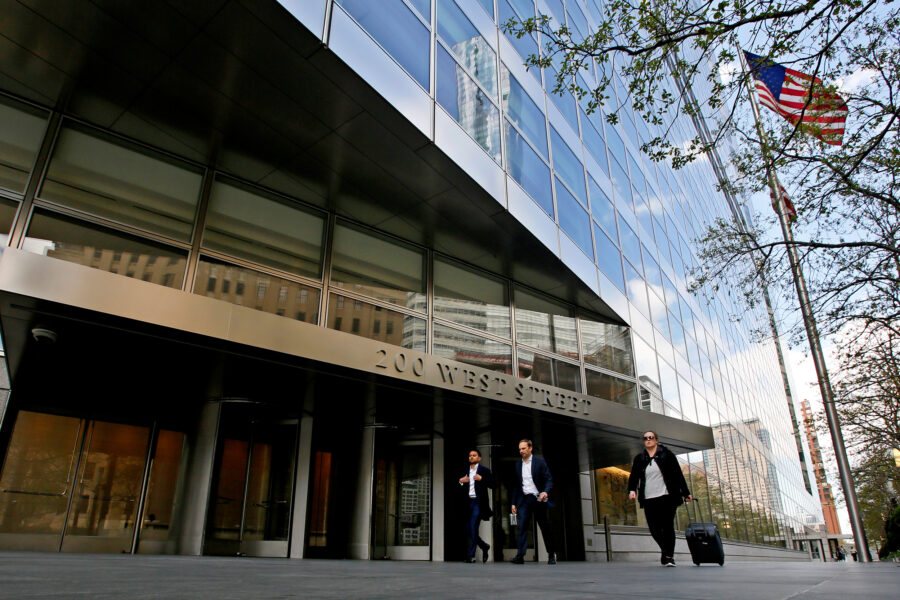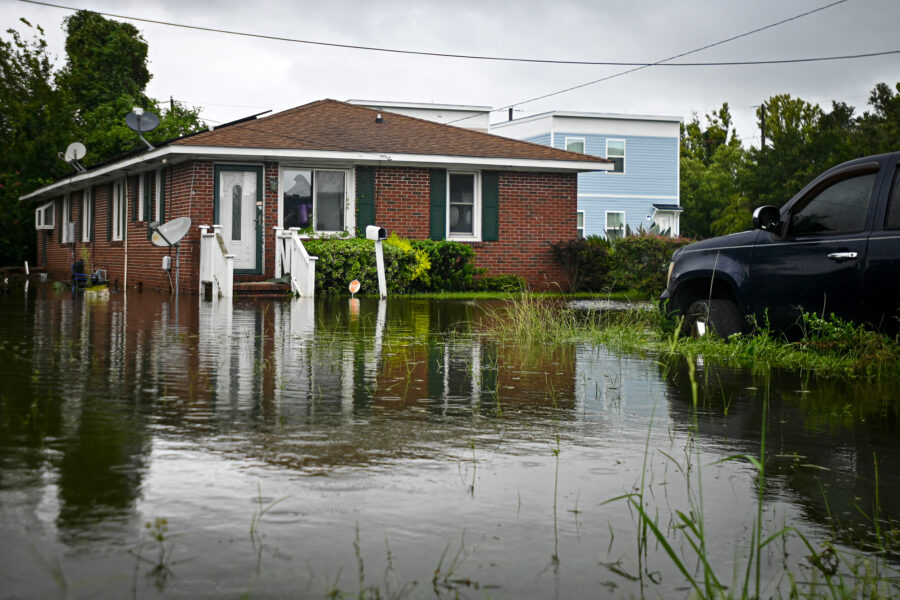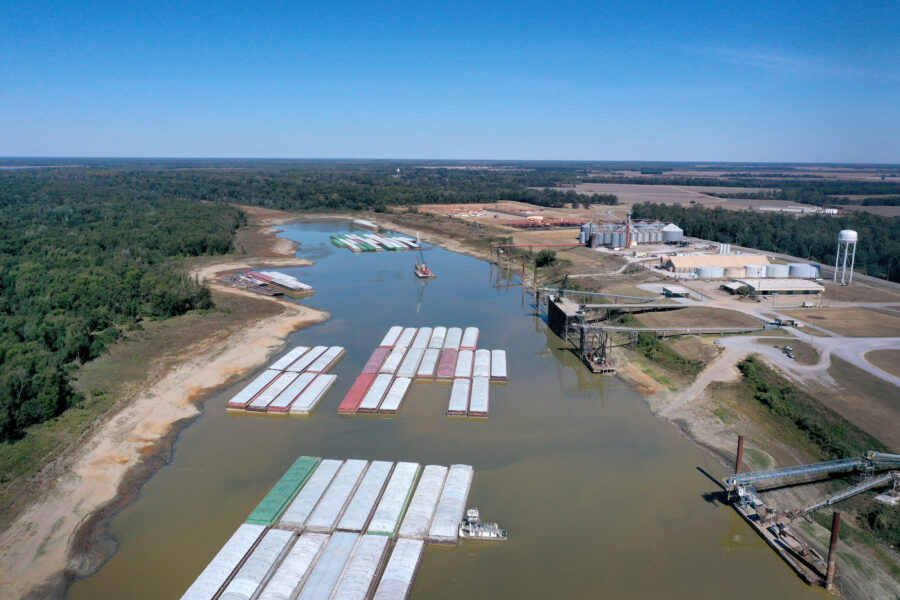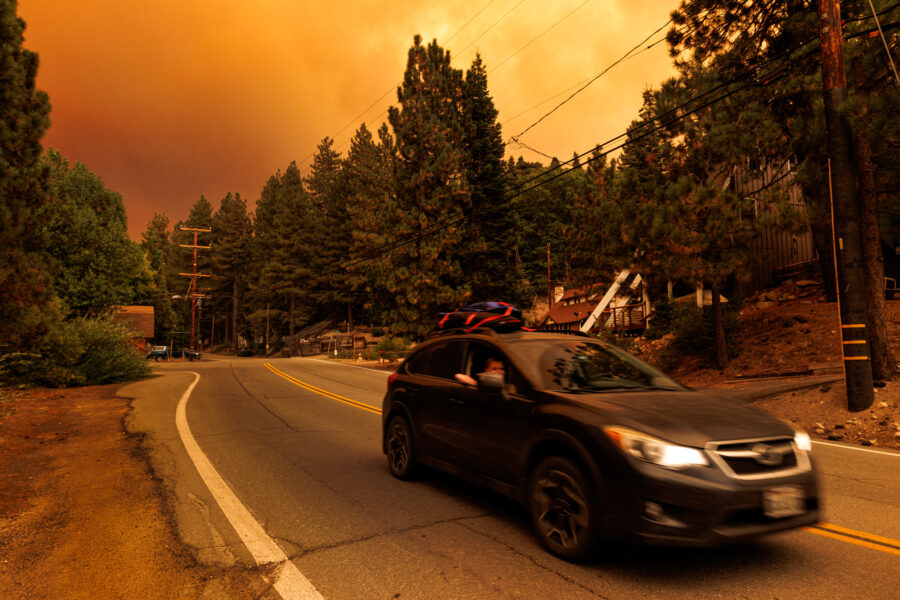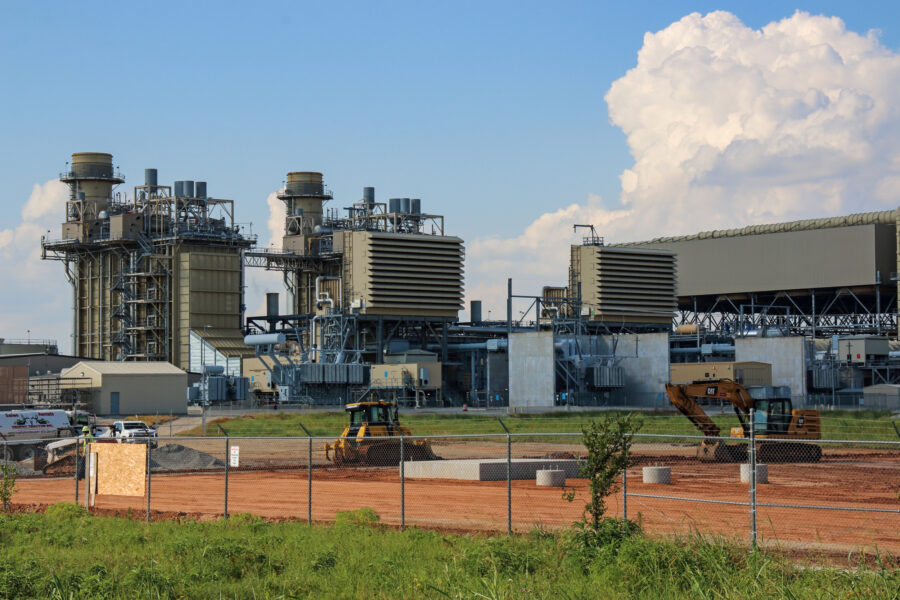NYC Environmental Justice Activists Feel Ignored by the City and the Army Corps on Climate Projects
On the second floor of a school building in Jamaica, Queens, New York City’s Department of Environmental Protection hosted a flood kit giveaway. It was a Tuesday evening in late July, just a couple weeks before the peak of the Atlantic hurricane season.
Beth DeFalco, the department’s deputy commissioner for public affairs, gave a speech to the community about how to use the flood kits, and to explain what climate change impacts the agency expects on their neighborhood, now and in the future.
This area of Queens suffers from consistent groundwater flooding because the water table is particularly high. This means that water rises through the soil and rock, invading residents’ homes.
“I know personally how scary it is to watch water come into your house and not know what to do, or how much is coming,” said DeFalco.
Explore the latest news about what’s at stake for the climate during this election season.
DeFalco herself lives in Red Hook and experiences flooding, especially in her basement. Every item the department distributed that evening, she has used in her own home to mitigate flooding. But ultimately, these kits are a Band-Aid for a larger problem: Climate change is causing more instances of extreme rainfall and large weather events.
Though these flood kits may effectively limit the amount of water entering someone’s home during an average storm, they cannot protect residents from worse conditions, like a hurricane.

“This isn’t going to help in an Ida storm, this isn’t going to help in Sandy. In fact, nothing’s going to help in Sandy,” said DeFalco, referring to hurricanes from 2021 and 2012. “There’s nothing that we’re giving you tonight, and there’s none of the sewer upgrades that we’re doing, that’s going to help in Sandy.”
That is the job of the larger, long-term infrastructure projects proposed by city departments and the U.S. Army Corps of Engineers.
In the past decade, the city and the Army Corps have designed and implemented a number of long-term plans, big and small, aimed at reducing the chance of flooding in certain areas, increasing the number of green jobs and limiting pollution in the waterways. But scholars and environmental justice communities lament the often-slow rollout of these plans, and the ways in which local input rarely translates into implementation.
These plans, they argue, would be more effective and better suited to their location if residents had more say in the design. Government officials are just beginning to listen.
Environmental justice communities are often praised for their resilience in the face of multiple climate threats. For many, this resilience is an expectation that they should recover over and over again from damage to their homes, or to their health, which they are more likely to experience due to historical disadvantages.
“What we’re arguing is essentially that they shouldn’t have to fight so hard to survive,” said Victoria Sanders, the climate and health manager for the New York City Environmental Justice Alliance. The nonprofit links local environmental justice organizations operating in low-income neighborhoods and communities of color.
“Wealthy communities, when worse comes to worse, they can get themselves out of this problem on their own—they have the money to protect themselves,” she said. “Whereas these vulnerable communities often don’t and need that extra protection that they are owed as residents.”
In response to these issues, and to frustration with the slow rollout of city plans, some local community organizations have created their own climate resilience policies and green economy plans for their neighborhood. For example, UPROSE, Brooklyn’s oldest Latino grassroots organization, created the Green Resilient Industrial District Plan in 2019. It identifies community concerns in Sunset Park, like gentrification, unemployment and flooding, and sets out a plan to address them without risking displacement or a fundamental change to how residents live.
“We are doing all the work on the ground, everything having to do with infrastructure, everything to do with planning and land use and zoning,” said Elizabeth Yeampierre, the executive director of UPROSE. “We are putting together entire policy pieces, and then the legislators—the people responsible for making that become operational—become the blocks. They’re thinking in old-school, dated, conventional ways that aren’t honoring the political moment that we’re in right now.”
Scholars like Paul Gallay, director of the Resilient Coastal Communities Project at Columbia Climate School, have also acknowledged academics’ historical failure to move their research forward from theory to practice.
“We are putting together entire policy pieces, and then the legislators—the people responsible for making that become operational—become the blocks.”
“I think academics have tended to be measured by standards associated with more pure research and less applied, practical research when it comes to advancing their careers, achieving tenure, achieving grant funding,” said Gallay. “The old idea of the ivory tower is yielding to an understanding that collaboration is the only way to actually advance community interests.”
Recently, Gallay published a study in the journal Geoforum in partnership with local environmental organizations, like the Environmental Justice Alliance, which sets out more equitable practices for community involvement in the city’s climate resilience plans.
‘Felt Very Much Like a Box Check’
The U.S. Army Corps of Engineers, which handles many of the city’s infrastructure plans to handle storm surge, has been accused of tokenism in its dealings with environmental justice communities, most recently in regard to their NY & NJ Harbor & Tributaries Focus Area Feasibility Study, which is still in the draft phase. The study looks at the flood risk in different parts of the city, and will feature measures such as walls and gates to mitigate flooding in those areas.
In a public comment on the study, the Environmental Justice Alliance expressed disappointment with how the term “environmental justice” had been used by the corps in a preliminary presentation.
“The slide was very bare bones—it didn’t talk deeply about any of the social vulnerabilities that cause environmental justice,” said Sanders. “It felt very much like a box check.”
El Puente, a human rights organization based in South Williamsburg, has been engaging with the Army Corps of Engineers on this study to try to ensure that local concerns are taken into account. Rami Dinnawi, the environmental justice campaign and policy manager at El Puente, found that the corps was overly concerned with protecting high-value real estate, rather than local communities.
“The way that the U.S. Army Corps of Engineers has been thinking about this prior to our engagement was protecting the most expensive properties on the waterfront to ensure that the amount of money that is being put into that project is recuperated in terms of asset and value,” said Dinnawi. “It is a plan that doesn’t prioritize communities. It prioritized property.”
Members of El Puente want to see more nature-based solutions to the flooding in their area rather than hard infrastructure, as well as an approach to flooding that is more neighborhood-specific.
“The U.S. Army Corps of Engineers, in our engagement with them, have continuously made promises, both publicly and in writing, based on our advocacy that they have not kept,” said Dinnawi. “It’s community co-opting in order to achieve something that the community doesn’t necessarily want or endorse.”
Community organizations are often asked to voice their priorities and concerns in city plans for climate resilience, but they can be pushed to the side in favor of what the city has deemed more financially viable or better in the short-term. In the Lower East Side, the Army Corps of Engineers was in talks with the local community about a coastal resilience project at East River Park when it suddenly approved a new design that residents had never seen before. This eroded local trust in the plan and led to multiple lawsuits, further delaying a project aimed to protect those most vulnerable to storm-surge flooding.
According to Gallay’s study, the Army Corps of Engineers also rarely takes a multi-hazard approach to its climate resilience plans, most often focusing solely on storm surge. This leaves scholars and some communities, like those that El Puente and UPROSE serve, concerned about the combined impact of sea level rise, extreme rainfall, contamination and storm surge.
In particular, a study by Eddie Bautista, executive director of the Environmental Justice Alliance, has found that six significant maritime industrial areas in the city, including the one in Sunset Park, are in hurricane storm surge zones and that, in the event of a flood, residents risk exposure to carcinogenic chemicals. These chemicals from earlier industrial activities contaminate the ground and could become dislodged during a flood.
Currently, the Army Corps of Engineers’ NY & NJ Harbor & Tributaries Focus Area Feasibility Study does not address this issue. Sanders hopes that corps officials will fix that in the next draft.
“There’s all these unintended negative consequences that can occur if you don’t plan appropriately for all of the things that might happen,” said Sanders.
According to Gallay, the states of New York and New Jersey have invoked a February update to the 2022 federal Water Resources Development Act—which requires that the Army Corps of Engineers frame its studies with multiple flood risks in mind—to ensure a more holistic approach to this study.
A spokesman for the U.S. Army Corps of Engineers wrote in an emailed statement that the agency “deeply values the input and insights from local communities in the design and planning phases of our projects.” The corps is committed to listening, gathering data and making revisions to the study as needed, the spokesman said.
In Newtown Creek, which separates Brooklyn and Queens, the Army Corps of Engineers, as part of the harbor and tributaries study, has a plan to install a storm-surge gate once environmental remediation has taken place on the waterway. The creek itself is a Superfund site due to a large ExxonMobil oil spill there, which was estimated at 17 million gallons.
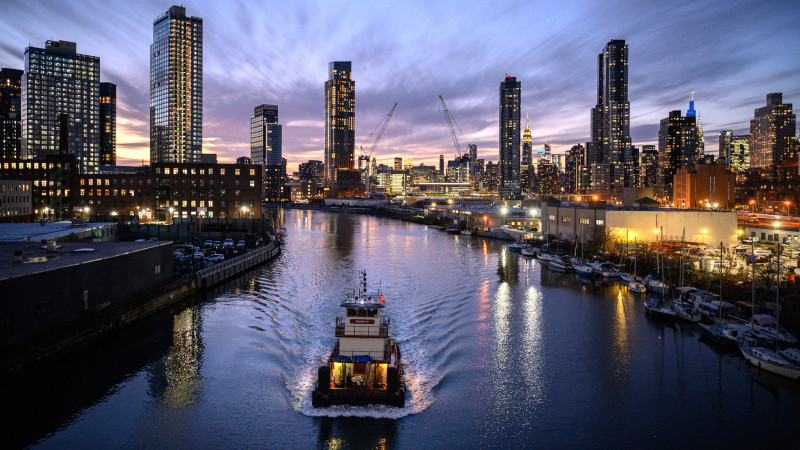
Willis Elkins, executive director of the Newtown Creek Alliance, an environmental justice organization, is concerned about how that will affect the health of the creek and the species that live in or along it. Multiple combined sewer overflows feed into the creek, discharging an estimated 1.2 billion gallons of sewage every year. He is concerned that a storm surge gate may impact the flow of sewage out into the harbor. He also worries it may increase flooding in certain areas surrounding the creek.
“If there’s a hurricane that comes and it’s dumping a ton of rain, then Newtown Creek is a major drainage area. All the combined sewers, all the separated sewers, are here, dumping millions and millions of gallons,” said Elkins. “So if you can’t pump it, if you can’t get it from one side of the barrier to the harbor side, then we’re just going to flood all the properties here anyway.”
When it comes to climate resilience plans, residents in environmental justice communities are also often deeply concerned about being displaced. Nature-based solutions to extreme rainfall and storm surge, like living shorelines, more parks and green roofs, which all absorb stormwater and can mitigate flooding, can also attract wealthy developers. This process is called green gentrification.
“Anytime that you improve the beauty and the functionality of an area, it can increase property values and make it harder for low-income people to stay in that area,” said Sanders. “That being said, it’s what a lot of those communities are asking for. They want more green infrastructure. They want those natural features, and they want access to the waterfront.”
Yeampierre extolls the value of community in Sunset Park and the ways in which it has enabled those in her neighborhood to keep each other safe and to prepare for possible disasters. UPROSE has spearheaded programs to train residents in first aid, and to teach local auto-salvage employees how to secure the carcinogenic chemicals that they use. During Superstorm Sandy in 2012, she sent activists to help communities in other areas of Brooklyn and Queens because Sunset Park was not hit as badly.
“I remember … seeing our young people heading out to the Rockaways, heading out to Red Hook and to other communities that were really devastated,” said Yeampierre. “We need to really think about how we center collective care in any community response to extreme weather events, because we often think about what happens if the cavalry doesn’t come.”
She worries that this collective care will be blunted if the neighborhood becomes gentrified. Her organization fought tooth-and-nail against a 16-building commercial development at Bush Terminal known as Industry City, which included hotels and retail space. She argued that it would greatly hasten gentrification in the area, pushing out the immigrant and low-income communities that have lived in Sunset Park for generations.
“When we were fighting Industry City,” said Yeampierre, “we were fighting it because we had a vision for the industrial sector not being a destination location for the privileged, for the parties, for the avocado toast.”
It was in this context that the original version of the Green Resilient Industrial District Plan was conceived, which laid out, among other things, a future in which the industrial zones supported green manufacturing and the use of renewable energy while providing local residents with jobs. The Industry City developers withdrew their plan in September 2020. This year, construction of an offshore wind turbine assembly facility began at the South Brooklyn Marine Terminal—a win for UPROSE, Yeampierre said.
Community organizations like UPROSE, El Puente and the Environmental Justice Alliance want to see community concerns, knowledge and priorities incorporated into the city’s climate resilience plans and green job policies. This year, the Army Corps of Engineers pledged to create an environmental justice coordinating committee, which would include leaders from the New York City Housing Authority, Columbia Climate School and El Puente. The committee would consult on the corps’ plans to ensure they served the wider community.
A spokesman for the Army Corps wrote in a statement that “we are in the process of establishing a forum to facilitate regular community engagement and foster a meaningful exchange of information on environmental justice.” The agency gave no timeline for the creation of this committee.
For Yeampierre, Dinnawi, and Sanders, an equitable partnership between government officials and local communities would improve climate resilience plans and ensure that they not only preserve the lives of residents, but also the character of their neighborhoods. In their view, broader investment in environmental justice communities is required to ensure that they are less vulnerable to the whims of extreme weather events, as well as less visible issues like gentrification and displacement.
“You cannot possibly understand what a community is going through based on projection models,” said Dinnawi. “It is choosing to look at a computer to figure out what salt tastes like when it is on a dish right in front of you, and you don’t want to touch it.”
About This Story
Perhaps you noticed: This story, like all the news we publish, is free to read. That’s because Inside Climate News is a 501c3 nonprofit organization. We do not charge a subscription fee, lock our news behind a paywall, or clutter our website with ads. We make our news on climate and the environment freely available to you and anyone who wants it.
That’s not all. We also share our news for free with scores of other media organizations around the country. Many of them can’t afford to do environmental journalism of their own. We’ve built bureaus from coast to coast to report local stories, collaborate with local newsrooms and co-publish articles so that this vital work is shared as widely as possible.
Two of us launched ICN in 2007. Six years later we earned a Pulitzer Prize for National Reporting, and now we run the oldest and largest dedicated climate newsroom in the nation. We tell the story in all its complexity. We hold polluters accountable. We expose environmental injustice. We debunk misinformation. We scrutinize solutions and inspire action.
Donations from readers like you fund every aspect of what we do. If you don’t already, will you support our ongoing work, our reporting on the biggest crisis facing our planet, and help us reach even more readers in more places?
Please take a moment to make a tax-deductible donation. Every one of them makes a difference.
Thank you,
David Sassoon
Founder and Publisher
Vernon Loeb
Executive Editor
Share this article
Disclaimer: The copyright of this article belongs to the original author. Reposting this article is solely for the purpose of information dissemination and does not constitute any investment advice. If there is any infringement, please contact us immediately. We will make corrections or deletions as necessary. Thank you.

